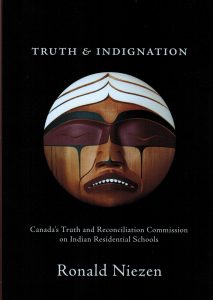It was an unnerving moment at a Victoria hearing of the Truth & Reconciliation Commission on Indian residential schools. An aging priest was to testify. There were no abuses at his school, he explained. Frankly the care was excellent, he recalled; there were aboriginal staff, and parents could visit anytime.
“Tell the truth!” voices shouted from the back. “Shame on you!” “Tell the truth!”
It was a significant moment, writes Professor Ronald Niezen. The old man’s testimony set off the audience: “He interrupted the boundary that separated the oppressed as a collectivity from those who have moral responsibility for their suffering”; “He questioned the foundational historical premise of the Commission itself, captured succinctly in the title of an interim historical report, They Came For The Children.”
Niezen is an anthropologist at McGill University. His book is as unnerving as the priest’s testimony.
The Truth & Reconciliation Commission, created from a class-action lawsuit, is not a forensic audit. It is neither a criminal investigation nor a fact-finding body. There is little reconciliation, and even truth is subjective: at one hearing a commissioner patiently explained the difference between “factual truths” and “relative truths”, Niezen writes.
“More than in any other truth commission, the Truth & Reconciliation Commission on Indian Residential Schools is concerned with mental illness”, he notes. As a result, testimony from former students “is complicated by the permissiveness of the hearings, and by the fact that there are no explicit limits to what one may or may not say into the microphone and before the cameras.”
No one disputes that abuses occurred at the schools that housed 150,000 children from 1867 to the closure of the last institutions in the 1980s. Niezen documents these outrages: the child forced to eat vomit; or the abused boy who froze to death while trying to walk home. The result is multiple apologies drafted by liability lawyers, and flat payments of $10,000 to all former students for the first year spent at school, with $3,000 for each year thereafter.
He interviews former priests and nuns, too, who express bafflement that they are as a class now depicted as sadists. “In my school in five years I never heard of physical abuse and sexual abuse,” one priest tells Niezen. “Years later this comes and all of a sudden you find out you are a criminal. That makes me mad. I’ve lost hours and hours of sleep over that business.”
The author goes further, noting the absence of any focus on the prominent role of the Government of Canada as the architect of the program.
Here is John Duncan, then-minister of aboriginal affairs, arriving late at a 2012 hearing in Saskatoon: “He began by saying that reconciliation cannot be expressed ‘unless we talk about it from a personal point of view.’ This was a lead-in to an autobiographical statement about how as a child his family was displaced from the town of Crow’s Nest Pass in Alberta, which was economically depressed and slated for demolition, and moved to Kamloops, British Columbia; how as a youth he worked as a busboy for the Pacific Railway; how, after getting a forestry degree, he worked in logging operations in which many of his fellow workers were aboriginal; and how he eventually ‘met a wonderful woman’ with whom he had ‘three wonderful children, all with [aboriginal] status.’ His final point was expressed succinctly: ‘I know about your culture. I know about your pain.’ Then he left early to catch a plane.”
Truth & Indignation is the first attempt by an eloquent observer to document what has become of the Truth & Reconciliation process. Oddly, the commission almost resembles the Indian schools themselves – a cruel, ambiguous, institutional response to conflict and failure.
Niezen’s book is a crisp analysis of an unfolding drama that seems certain to end badly. It is all the more poignant by the fact it was so well-intentioned. In the end readers are left with the words of the shaken priest, Brother Tom Cavanaugh, attempting to tell his story in Victoria:
- CAVANAUGH: “There didn’t seem to be any other viable alternative in providing a good education for so many children who lived in relatively small, isolated communities.”
- AUDIENCE MEMBERS (sobbing): “Truth!” “Tell the truth!” “You’re not telling the truth!”
- CAVANAUGH: “The Native staff who were related to a number of the children along with the other staff, I felt, provided a good education, as well as excellent care and guidance.”
- AUDIENCE: “Tell the truth! Shame on you! We never sent our children to a residential school.”
- CAVANAUGH: “Parents were encouraged to visit the school and rooms were available, if they wished to stay overnight with their children.”
- AUDIENCE: “Tell the truth!”
By Holly Doan
Truth & Indignation: Canada’s Truth and Reconciliation Commission on Indian Residential Schools, by Ronald Niezen; 192 pages; ISBN 9781-44260-6302; $24.95 





